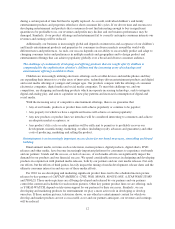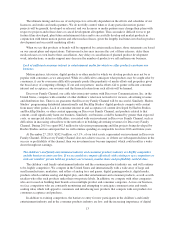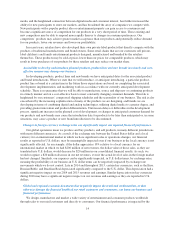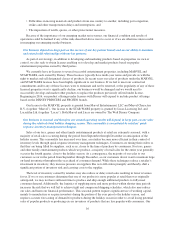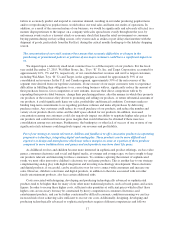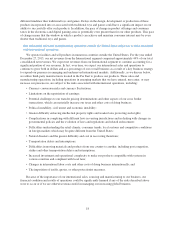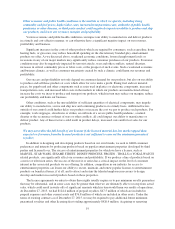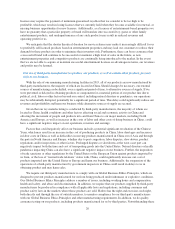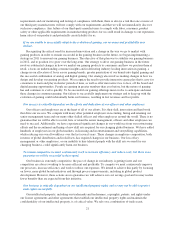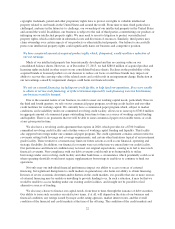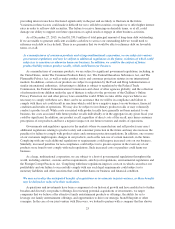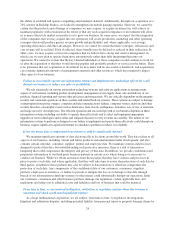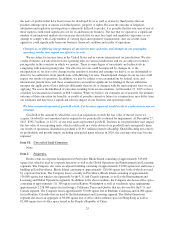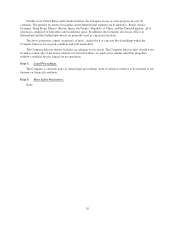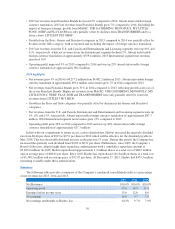Hasbro 2015 Annual Report Download - page 31
Download and view the complete annual report
Please find page 31 of the 2015 Hasbro annual report below. You can navigate through the pages in the report by either clicking on the pages listed below, or by using the keyword search tool below to find specific information within the annual report.licenses may require the payment of minimum guaranteed royalties that we consider to be too high to be
profitable, which may result in losing licenses that we currently hold when they become available for renewal, or
missing business opportunities for new licenses. Additionally, as a licensee of entertainment-based properties we
have no guaranty that a particular property or brand will translate into successful toy, game or other family
entertainment products, and underperformance of any such products may result in reduced revenues and
operating profit for us.
We anticipate that the shorter theatrical duration for movie releases may make it increasingly difficult for us
to profitably sell licensed products based on entertainment properties and may lead our customers to reduce their
demand for these products in order to minimize their inventory risk. Furthermore, there can be no assurance that
a successful brand will continue to be successful or maintain a high level of sales in the future, as new
entertainment properties and competitive products are continually being introduced to the market. In the event
that we are not able to acquire or maintain successful entertainment licenses on advantageous terms, our revenues
and profits may be harmed.
Our use of third-party manufacturers to produce our products, as well as certain other products, presents
risks to our business.
With the sale of our remaining manufacturing facilities in 2015, all of our products are now manufactured by
third-party manufacturers, the majority of which are located in China. Should changes be necessary, our external
sources of manufacturing can be shifted, over a significant period of time, to alternative sources of supply. If we
were prevented or delayed in obtaining products or components for a material portion of our product line due to
political, civil, labor or other factors beyond our control, including natural disasters or pandemics, our operations
may be substantially disrupted, potentially for a significant period of time. This delay could significantly reduce our
revenues and profitability and harm our business while alternative sources of supply are secured.
Given that our toy manufacturing is conducted by third-party manufacturers, the majority of whom are
located in China, health conditions and other factors affecting social and economic activity in China and
affecting the movement of people and products into and from China to our major markets, including North
America and Europe, as well as increases in the costs of labor and other costs of doing business in China, could
have a significant negative impact on our operations, revenues and earnings.
Factors that could negatively affect our business include a potential significant revaluation of the Chinese
Yuan, which may result in an increase in the cost of producing products in China, labor shortages and increases
in labor costs in China as well as difficulties in moving products manufactured in China out of Asia and through
the ports in North America and Europe, whether due to port congestion, labor disputes, slow downs, product
regulations and/or inspections or other factors. Prolonged disputes or slowdowns at the west coast port can
negatively impact both the time and cost of transporting goods into the United States. Natural disasters or health
pandemics impacting China can also have a significant negative impact on our business. Further, the imposition
of trade sanctions or other regulations by the United States or the European Union against products imported by
us from, or the loss of “normal trade relations” status with, China, could significantly increase our cost of
products imported into the United States or Europe and harm our business. Additionally, the suspension of the
operations of a third-party manufacturer by government inspectors in China could result in delays to us in
obtaining product and may harm sales.
We require our third-party manufacturers to comply with our Global Business Ethics Principles, which are
designed to prevent products manufactured for us from being produced under inhumane or exploitive conditions.
Our Global Business Ethics Principles address a number of issues, including working hours and compensation,
health and safety, and abuse and discrimination. In addition, we require that our products supplied by third-party
manufacturers be produced in compliance with all applicable laws and regulations, including consumer and
product safety laws in the markets where those products are sold. Hasbro has the right and exercises such right,
both directly and through the use of outside monitors, to monitor compliance by our third-party manufacturers
with our Global Business Ethics Principles and other manufacturing requirements. In addition, we do quality
assurance testing on our products, including products manufactured for us by third parties. Notwithstanding these
20




